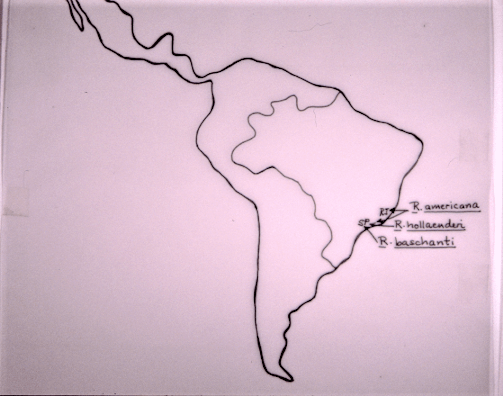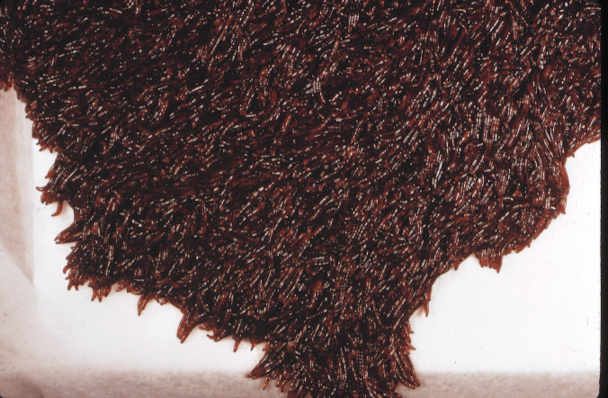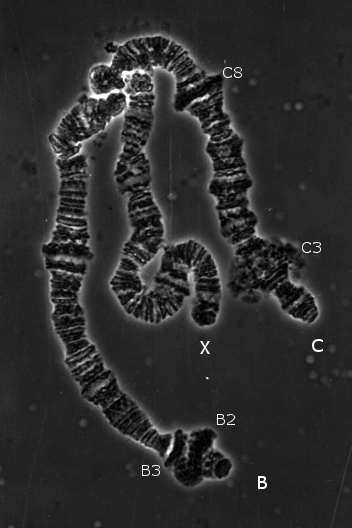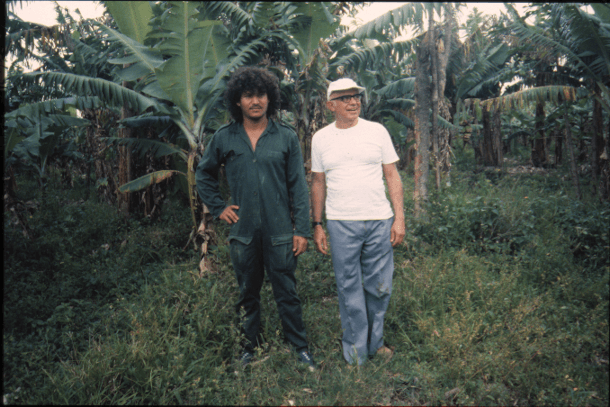
Collecting Rhynchosciara: an important fly in the history of genetics
Words and images: Ann Stocker
Rhynchosciara species are endemic to South and Central America. The larvae are readily observed because they are a centimeter or more in length, usually reddish in colour and travel in groups of dozens to hundreds of individuals (Fig 1). However, they only came to the attention of biologists after Crodowaldo Pavan, a Professor at the University of Sao Paulo (Brazil), and his assistant, Marta Breuer, looked at their salivary gland chromosomes and thought they saw evidence of unequal replication at some bands. Pavan said that he kicked some ground debris in a banana plantation and found a group of larvae which he took back to the lab to examine. They proved to have very large salivary gland chromosomes. While studying changes in these chromosomes during larval development with Marta, he noticed that some bands appeared significantly thicker at the end of larval development. Usually the site formed a large puff and then regressed in a thickened condition (Fig. 2). This indication of DNA amplification was the first of its kind made by geneticist outside of the “first world” at about the same time Watson and Crick described the structure of DNA in Cambridge. It was the earliest contradiction of DNA constancy theory, and brought Pavan (and the Genetics Department of the University of Sao Paulo) to the scientific world’s attention. This and other favorable cytological characteristics of Rhynchosciara led to a large number of cytological studies by Pavan and his students. Pavan acquired a Professorial position at the University of Texas at Austin in the early 1970s and that was where I got to know Rhynchosciara.
Fig. 1 Combined groups of Rhynchosciara americana larvae moving together. Type of movement and size suggest that they are female.
Fig. 2 Three of R. americana’s salivary gland polytene chromosomes, B, C, X. B2, B3, C3, C8 indicate DNA amplifying regions. The B2 DNA puff is regressing and C3 is about maximum. These 2 sites have been the most thoroughly investigated.
I had just finished my PhD at Southwestern Medical School in Dallas, Texas and was offered a post-doctoral position with Pavan in Austin. I worked there with him for several years on the induction of DNA puffs by ecdysone. We were using a species of Rhynchosciara called R. hollaenderi which is very similar to the species on which Pavan had made his discovery, but which could be maintained more easily in the laboratory.
However, the big problem with doing research on any Rhynchosciara species is maintaining stocks in the laboratory. Sciarid larvae are fungus feeders, and a tailored fermented food was eventually developed. Each new batch was produced by including a small amount of “starter culture” from the previous batch. Rhynchosciara development is complicated and full-time care is required to maintain a useful study population. The flies are unisexual producers, thus a number of crosses must be made to maintain both males and females. The females only mate once (Fig 3) and lay a single large egg mass. The larvae are large and develop over a long period and must be maintained in groups in order to develop successfully. Colonies can die out if only one sex is produced during their short period as adults. Field collection to replenish stocks was always a necessity, even in Texas when new larvae sometimes had to be brought in from Brazil.
Fig. 3 A copulating Rhynchosciara pair. The large black flies are about 1 cm long.
I left Texas for Melbourne in 1974, bringing R. hollaenderi with me. I was working on a journal manuscript and wanted to complete it the study. I did finish this manuscript but eventually had to give up Rhynchosciara as a study species. I should have left the flies in Texas as it was not possible to get fresh larvae from Brazil to Australia. After a few years Pavan returned to Sao Paulo and Rhynchosciara was raised there exclusively.
I first travelled to Brazil in 1979, not to work with Pavan, who was by then more involved with the politics of science than research, but with Francisco Lara, a biochemist who was using new molecular methods to explain the structure and function of the amplified sites. Professor Lara became a very important person in the Brazilian scientific community. Mainly using Rhynchosciara as a study organism, he trained a second generation of Brazilian biochemists who went on to very important positions. Lara also attracted well-known foreign scientists such as David Glover to participate in his work. I worked off and on with Professor Lara until his retirement from academia.
The main species that we worked with in Sao Paulo was R. americana. The starter food used to maintain the larvae had been lost and the correct ferment could not be replicated although Lara claimed success with ground nettle and sweet potato leaves. During the time I was in Sao Paulo, the larvae were fed chopped sweet potato leaves, but these were not entirely successful for long-term colony maintenance, in particular for young larvae. Possibly some essential fungus was present in the guts of freshly collected larvae, or in the leaves. It seemed the fermented food this time was not adequate to raise successive generations. Regular collecting trips became a necessity.
Every spring members of the lab would undertake several trips to the coast near Santos or Ubatuba (Fig 4) to collect larvae for the year’s experiments. It was usually a weekend trip and Lara often went as well. We would pack a university car with shovels, rakes, gloves, insect repellent, pans with cloth covers to contain the larvae we hoped to collect and a large sack for sweet potato leaves. For ourselves we took a change of clothes since we would usually stay overnight somewhere. We might also take some food and drink but we would usually eat our main meals at a local restaurant. The trip to Santos took one to two hours over the Anchieta Highway through the Serra do Mar. It was a drop from 760 meters to sea level, from the temperate climate of Sao Paulo to the warm, humid climate of the coast. Santos trips were sometimes only one day—if we were lucky and found larvae. Trips to Ubatuba, where Lara had a beach house (Fig. 5), took several days but it was a beautiful area. We would select a banana plantation, drive in and walk through rows of trees laden with green bananas, raking through the debris in the hope of finding a wriggling larval mass. If the weather had been wet we would sometimes find larvae travelling along the surface of the road in considerable numbers. If it had been too dry we most likely would not find anything. Vanildo, a technician in the lab was very good at finding larvae. (Fig 6) He could talk with the caboclos and ask them if they had seen any larval masses. Sometimes they had but would say that, unfortunately, they poisoned them. The folk tales in the area were that the larvae caused Athlete’s Foot (Freira in Portuguese). There were lots of insects beside Rhynchosciara in the banana plantation. The worst were mosquitos and small dark colored flies called Borrachudas. I called them barracudas due to their vicious bites, you didn’t notice until after they bit you and then the bite would really hurt. Even though it was usually hot and humid, we usually wore long sleeves and trousers and applied insecticide to ward off attacks. I happened to be allergic to the insecticide and would get very bad headaches if I applied it to my face. When we went to Ubatuba, Lara would sometimes ask the local boys to help (Fig 7). Vanildo made friends with a property owner named Señor Amaro on the way to Santos. Amaro stopped using poisons and we made a collecting base there. Vanildo could call him ahead of a trip and ask if he had seen any larvae. Amaro had a bar and had dammed a small creek for swimming. We would have a barbecue there after our collecting. However, over the years with time and weather changes the species of Rhynchosciara we wanted became increasingly difficult to find. Amaro’s property also became more dangerous as drug cartels moved into the region. People were murdered, their bodies left in the woodland. Collecting became dangerous because if you came upon a killing in progress, you were likely to be killed too. Understandably, the technicians did not want to go there anymore. The degradation of the habitat also meant that R. americana and R. hollaenderi larval groups were hard to find although another species was common in early spring.

Fig. 4 Map of Brazil showing coastal collecting regions.
Fig. 5 Vanildo aka “Vanis” and Lara (right) in a banana plantation.
Fig. 6 View from the shore near Lara’s beach house in Ubatuba.
Fig. 7 Lara and local boys in a banana plantation.
By that time Lara had retired and I went less frequently to Brazil. Most of the questions that we wanted to answer with this species had been answered. Techniques had changed and the size and polytene chromosomes of Rhynchosciara were outweighed by its difficulty to collect and maintain. However, two laboratories in Sao Paulo still work with Rhynchosciara. There is at least one DNA library that can be probed and some collections, usually by paid locals, are still done. A great deal of interesting work was done using Rhynchosciaria, and is still being done, but mainly with two smaller species of Sciara that are easier to maintain in the laboratory. The pioneers of DNA puffs are now dead and their names and work have been forgotten by most young scientists. However, Rhynchosciara and its DNA puffs retain an important place in the history of genetics.





